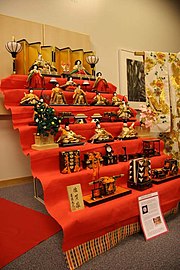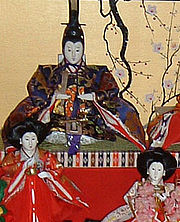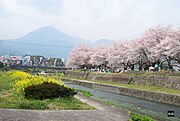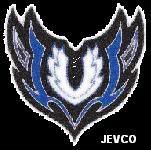Japanese festivals are traditional festive occasions. Some festivals have their roots in Chinese festivals but have undergone dramatic changes as they mixed with local customs.
 Some are so different that they do not even remotely resemble the original festival despite sharing the same name and date. There are also various local festivals (e.g. Tobata Gion) that are mostly unknown outside a given prefecture. It is commonly said that you will always find a festival somewhere in Japan.
Some are so different that they do not even remotely resemble the original festival despite sharing the same name and date. There are also various local festivals (e.g. Tobata Gion) that are mostly unknown outside a given prefecture. It is commonly said that you will always find a festival somewhere in Japan.
Unlike most people of East Asian descent, Japanese people generally do not celebrate Chinese New Year (it having been supplanted by the Western New Year’s Day in the late 19th century); although Chinese residents in Japan still do. In Yokohama Chinatown, Japan’s biggest Chinatown, tourists from all over Japan come to enjoy the festival. And similarly the Nagasaki Lantern Festival is based in Nagasaki’s China town.
Events within Festivals
Festivals are often based around one or two main events, with food stalls, entertainment, and carnival games to keep people entertained. Some are based around temples or shrines, others hana-bi (Fireworks), and still others around contests where the participants sport loin cloths…

Types and Participation
These Matsuri often happen in one of two times of year, but rarely both times at the same place.
- It is common that mud is involved in the festivities in some way, and this no doubt lends to the entertainment.
- Hadaka matsuri held in summer tend to involve participants in loincloths carrying mikoshi, while carrying portable shrines.
- Hadaka matsuri held in winter tend to involve ritual purification by water followed by a mass fight for a holy object (such as a stick, jewel, etc) that symbolizes the event.
- Participants are often adult males, who try to cultivate a strong image; however, young boys and girls have been known at times to participate, and in this sense the festival can become a rite of passage for young participants. Most naked festivals limit participation to adult males, but many have separate events where youth may participate, allowing communities to pass their traditions from generation to generation.
- Some locations are dedicated to young men’s (or rarer still, women’s) hadaka matsuris. This is more common in Western Japan.
- Some places have changed their hadaka matsuri traditions, and switched to female sumo instead.
- Like other festivals in Japan, hadaka matsuri have multiple forms of entertainment for spectators, including stalls with food and games, and taiko drumming. Tourists often travel to see the spectacle.
Controversy
The nature of these festivals, with their scantly-clad participants, is not usually an issue in Japan. In fact, when participants do get naked, it is usually considered a healthy, sacred act, and not indecent. However, some controversies do exist.
- Safety among slippery mud and water, and due to exposure, can be a concern.
- One looming problem for some festivals has been the participation of unsavory characters looking to gain monetary prizes. Some festival organizers claim that yakuza participant numbers have risen, leading to aggravated violence in what are supposed to be jovial bouts.
- Some festivals, such as the Doro mochi tsuki in Tara, Saga have been more subdued in recent years, due to unwanted attention from the media, and the claim that people are forgetting the true, religious meaning behind the festival.
Local Festivals (Matsuri)
Matsuri (祭?) is the Japanese word for a festival or holiday. In Japan, festivals are usually sponsored by a local shrine or temple, though they can be secular.
There is no specific matsuri days for all of Japan; dates vary from area to area, and even within a specific area, but festival days do tend to cluster around traditional holidays such as Setsubun or Obon. Almost every locale has at least one matsuri in late summer/early autumn, usually related to the rice harvest.
Notable matsuri often feature processions which may include elaborate floats. Preparation for these processions is usually organized at the level of neighborhoods, or machi. Prior to these, the local kami may be ritually installed in mikoshi and paraded through the streets.
One can always find in the vicinity of a matsuri booths selling souvenirs and food such as takoyaki, and games, such as Goldfish scooping. Karaoke contests, sumo matches, and other forms of entertainment are often organized in conjunction with matsuri. If the festival is next to a lake, renting a boat is also an attraction.
Favorite elements of the most popular matsuri, such as the Nada Kenka Matsuri of Himeji or the Neputa Matsuri of Hirosaki, are often broadcast on television for the entire nation to enjoy.
Some examples of famous matsuri are the Jidai, Aoi and Gion Matsuri held in Kyoto; Tenjin Matsuri in Osaka; and the Kanda Matsuri, Sannō and Sanja Matsuri of Tokyo. Especially, Gion Matsuri, Tenjin Matsuri, and Kanda Matsuri are the three most famous Matsuri in Japan.
Nationwide Festivals
Fixed days
- Seijin Shiki : Coming of Age Day (second Monday of January)
- Hinamatsuri : Doll Festival (3 March)
- Hanami : Flower Viewing (late March to early April)
- Tanabata : star festival (7 July)
- Shichi-Go-San: festival day for children aged three, five and seven (15 November)
- Ōmisoka : New Year’s Eve (31 December)
Multiple days
- Setsubun : division of season (beginning of each season (spring, summer, autumn, winter)
- Ennichi : temple fair (holy days related to Kami and/or Buddha)
Bunkasai
• New Year (正月 Shōgatsu)
Date: 1st-3rd of January (though related celebrations take place throughout January)
Other Names: Oshōgatsu (O is an honorific prefix)
Information: New Year observances are the most important and elaborate of Japan’s annual events. Before the New Year, homes are cleaned, debts are paid off, and osechi (food in lacquered trays for the New Year) is prepared or bought. Osechi foods are traditional foods which are chosen for their lucky colors, shapes, or lucky-sounding names in hopes of obtaining good luck in various areas of life during the new year. Homes are decorated and the holidays are celebrated by family gatherings, visits to temples or shrines, and formal calls on relatives and friends. The first day of the year (ganjitsu) is usually spent with members of the family.
 People try to stay awake and eat toshikoshisoba, which is soba noodles that would be eaten to at midnight. People also visit Buddhist temples and Shinto shrines. Traditionally three shrines or temples are visited. This is called sansha-mairi. In the Imperial Palace at dawn on the 1st of January, the emperor performs the rite of shihōhai(worship of the four quarters),in which he does reverence in the direction of various shrines and imperial tombs and offers prayers for the well-being of the nation. On January 2 the public is allowed to enter the inner palace grounds; the only other day this is possible is the emperor’s birthday (December 23). On the 2nd and 3rd days acquaintances visit one another to extend greetings (nenshi) and sip otoso (a spiced rice wine). Some games played at New Year’s are karuta (a card game), hanetsuki (similar to badminton), tako age (kitelflying), and komamawashi (spinning tops). These games are played to bring more luck for the year. Exchanging New Year’s greeting cards (similar to Christmas Cards in Western countries) is another important Japanese custom. Also special allowances are given to children, which are called otoshidama. They also decorate there entrances with kagami-mochi (2 mochi rice balls placed one on top of the other, with a tangerine on top), and kadomatsu (pine tree decorations).
People try to stay awake and eat toshikoshisoba, which is soba noodles that would be eaten to at midnight. People also visit Buddhist temples and Shinto shrines. Traditionally three shrines or temples are visited. This is called sansha-mairi. In the Imperial Palace at dawn on the 1st of January, the emperor performs the rite of shihōhai(worship of the four quarters),in which he does reverence in the direction of various shrines and imperial tombs and offers prayers for the well-being of the nation. On January 2 the public is allowed to enter the inner palace grounds; the only other day this is possible is the emperor’s birthday (December 23). On the 2nd and 3rd days acquaintances visit one another to extend greetings (nenshi) and sip otoso (a spiced rice wine). Some games played at New Year’s are karuta (a card game), hanetsuki (similar to badminton), tako age (kitelflying), and komamawashi (spinning tops). These games are played to bring more luck for the year. Exchanging New Year’s greeting cards (similar to Christmas Cards in Western countries) is another important Japanese custom. Also special allowances are given to children, which are called otoshidama. They also decorate there entrances with kagami-mochi (2 mochi rice balls placed one on top of the other, with a tangerine on top), and kadomatsu (pine tree decorations).
Kadomatsu traditional decoration
for The New year Holiday
A later New Year’s celebration, Koshōgatsu, literally means “Small New Year” and starts with the first full moon of the year (around January 15th). The main events of Koshōgatsu are rites and practices praying for a bountiful harvest.
The Japanese celebrate New Year’s Day on January 1 each year. Before 1873, the date of the Japanese New Year (正月 shōgatsu?) was based on the Chinese lunisolar calendar and celebrated at the beginning of spring, just as the contemporary Chinese, Korean and Vietnamese New Years are celebrated to this day. However, in 1873, five years after the Meiji Restoration, Japan adopted the Gregorian calendar, so the first day of January is the official New Year’s Day in modern Japan. It is considered by most Japanese to be one of the most important annual festivals and has been celebrated for centuries with its own unique customs.
Traditional food
Japanese people eat a special selection of dishes during the New Year celebration called osechi-ryōri (御節料理 or お節料理?), typically shortened to osechi. A popular soup is ozōni (お雑煮?), consisting of miso, boiled seaweed (昆布 konbu?), fish cakes (蒲鉾 kamaboko?), mashed sweet potato with chestnut (栗きんとん kurikinton?), simmered burdock root (金平牛蒡 kinpira gobo?), and sweetened black soybeans (黒豆 kuromame?). Many of these dishes are sweet, sour, or dried, so they can keep without refrigeration—the culinary traditions date to a time before households had refrigerators, when most stores closed for the holidays. There are many variations of osechi, and some foods eaten in one region are not eaten in other places (or are even banned) on New Year’s Day. Today, sashimi and sushi are often eaten, as well as non-Japanese foods. To let the overworked stomach rest, seven-herb rice soup (七草粥 nanakusa-gayu?) is prepared on the seventh day of January, a day known as jinjitsu (人日?).
POST CARDS
 The end of December and the beginning of January are the busiest times for the Japanese post offices. The Japanese have a custom of sending New Year’s Day postcards (年賀状 nengajō?) to their friends and relatives. It is similar to the Western custom of sending Christmas cards. Their original purpose was to give your faraway friends and relatives tidings of yourself and your immediate family. In a manner of speaking, this custom existed for people to tell others whom they did not often meet that they were alive and well.
The end of December and the beginning of January are the busiest times for the Japanese post offices. The Japanese have a custom of sending New Year’s Day postcards (年賀状 nengajō?) to their friends and relatives. It is similar to the Western custom of sending Christmas cards. Their original purpose was to give your faraway friends and relatives tidings of yourself and your immediate family. In a manner of speaking, this custom existed for people to tell others whom they did not often meet that they were alive and well.
Japanese people send these postcards so that they arrive on the 1st of January. The post office guarantees to deliver the greeting postcards by the first of January if they are posted within a time limit, from mid-December to near the end of the month and are marked with the word nengajo. In order to deliver these cards on time, the post office usually hires students part-time to help deliver the letters.
It is customary not to send these postcards when one has had a death in the family during the year. In this case, a simple postcard is sent instead to inform friends and relatives that they should not send joyful New Year’s cards, in order to show respect for the deceased.
People get their nengajō from many sources. Stationers sell preprinted cards. Most of these have the Chinese zodiac sign of the New Year as their design, or conventional greetings, or both. The Chinese zodiac has a cycle of 12 years. Each year is represented by an animal. The animals are, in order: rat, cow, tiger, rabbit, dragon, snake, horse, sheep, monkey, rooster, dog, and boar. 2006, was the year of the dog; 2007 was the year of the boar, and 2008 is the year of the rat. For 2006, famous dogs like Snoopy and other cartoon characters were especially popular.
The postcards may have spaces for the sender to write a personal message. Blank cards are available, so people can hand-write or draw their own. Rubber stamps with conventional messages and with the annual animal are on sale at department stores and other outlets, and many people buy ink brushes for personal greetings. Special printing devices are popular, especially among people who practice crafts. Software also lets artists create their own designs and output them using their computer’s color printer. Because a gregarious individual might have hundreds to write, print shops offer a wide variety of sample postcards with short messages so that the sender has only to write addresses. Even with the rise in popularity of email, the nengajō remains very popular in Japan.
Conventional nengajō greetings include:
- kotoshi mo yoroshiku o-negai-shimasu (今年もよろしくお願いします?) I hope for your favour again in the coming year
- (shinnen) akemashite o-medetō-gozaimasu ((新年)あけましておめでとうございます?) Happiness to you on the dawn (of a New Year)
- kinga shinnen (謹賀新年?) Happy New Year
- shoshun (初春?) literally “early spring”
Otoshidama

Mochi
Another custom is creating rice cakes (餅 mochi?). Boiled sticky rice (餅米 mochigome?) is put into a wooden shallow bucket-like container and patted with water by one person while another person hits it with a large wooden hammer. By mashing the rice, it gets sticky and forms a sticky white dumpling. This is made before New Year’s Day and eaten during the beginning of January.
Mochi is also made into a New Year’s decoration called kagami mochi (鏡餅?), formed from two round cakes of mochi with a bitter orange (橙 daidai?) placed on top. The name daidai is supposed to be auspicious since it means “several generations.”
Because of mochi’s extremely sticky texture, there are many deaths by choking on New Year in Japan, particularly in the elderly population. The death toll is reported in newspaper publications the day after New Year.
Poetry
The New Year traditions are also a part of Japanese poetry, including haiku and renga. All of the traditions above would be appropriate to include in haiku as kigo (season words). There also haiku that celebrate many of the “first” of the New Year, such as the “first sun” (hatsuhi) or “first sunrise“, “first laughter” (waraizome—starting the New Year with a smile is considered a good sign), and first dream (hatsuyume). Since the traditional New Year was later in the year than the current date, many of these mention the beginning of spring.
Along with the New Year’s Day Postcard, haiku might mention “first letter” (hatsudayori—meaning the first exchange of letters), “first calligraphy” (kakizome), and “first brush” (fude hajime).
Games
It was also customary to play many New Year’s games. These include hanetsuki, takoage (kite flying), koma (top), sugoroku, fukuwarai (whereby a blindfolded person places paper parts of a face, such as eyes, eyebrows, a nose and a mouth, on a paper face), karuta, and others.
Hatsumōde, hatsuhinode, the “firsts” of the year
Celebrating the new year in Japan also means paying special attention to the “first” time something is done in the new year. Hatsuhinode (初日の出) is the first sunrise of the year. Before sunrise on January 1, people often drive to the coast or climb a mountain so that they can see the first sunrise of the new year. Hatsumōde (初詣) is the first trip to a shrine or temple. Many people visit a shrine after midnight on January 1 or sometime during the day on January 1. If the weather is good, people often dress up or wear kimono. Other “firsts” that are marked as special events include shigoto-hajime (仕事始め, the first work of the new year), keiko-hajime (稽古始め, the first practice of the new year), and hatsugama, the first tea ceremony of the new year.
•Doll Festival ( Hina Matsuri)
Date: 3rd of March
Other Names: Sangatsu Sekku (3rd month Festival), Momo Sekku (Peach Festival), Joshi no Sekku (Girls’ Festival)
 Information: This holiday is also known as the Peach Festival because peach blossoms herald the coming of spring and are the symbol of courage and feminine beauty. Young girls put on their best kimonos and visit their friends’ homes. Tiered platforms for hina ningyō (hina dolls; a set of dolls representing the emperor, empress, attendants, and musicians in ancient court dress) are set up in the home, and the family celebrates with a special meal of hishimochi (diamond-shaped rice cakes) and shirozake (rice malt with sake).
Information: This holiday is also known as the Peach Festival because peach blossoms herald the coming of spring and are the symbol of courage and feminine beauty. Young girls put on their best kimonos and visit their friends’ homes. Tiered platforms for hina ningyō (hina dolls; a set of dolls representing the emperor, empress, attendants, and musicians in ancient court dress) are set up in the home, and the family celebrates with a special meal of hishimochi (diamond-shaped rice cakes) and shirozake (rice malt with sake).
The Japanese Doll Festival (雛祭り Hina-matsuri?), or Girls’ Day, is held on March 3, the third day of the third month. Platforms with a red hi-mōsen are used to display a set of ornamental dolls (雛人形 hina-ningyō?) representing the Emperor, Empress, attendants, and musicians in traditional court dress of the Heian period.
Placement
The Kantō region and Kansai region have different placement orders of the dolls from right to left, but the order of dolls per level are the same.
The term for the platform in Japanese is hina dan (雛壇?). The layer of covering is called dankake (段掛?) or simply mousen (毛氈?), a red carpet with rainbow-striped at the bottom.
Fist Platform
 The top tier holds two dolls, known as Imperial dolls (内裏雛 (だいりびな) da-i-ri-bi-na?) representing the Emperor (御内裏様 O-dairi-sama?) and Empress (御雛様 O-hina-sama?) (dairi means “Imperial Palace“, and hina means “girl” or “princess”).
The top tier holds two dolls, known as Imperial dolls (内裏雛 (だいりびな) da-i-ri-bi-na?) representing the Emperor (御内裏様 O-dairi-sama?) and Empress (御雛様 O-hina-sama?) (dairi means “Imperial Palace“, and hina means “girl” or “princess”).
The dolls are usually placed in front of a gold folding screen (屏風 byōbu?).
Optional are the two lampstands are called bonbori (雪洞?), and the paper or silk lanterns are known as hibukuro (火袋?), usually decorated with cherry or plum blossom patterns.
Complete sets would include accessories placed between the two figures, known as sanbou kazari (三方飾り?), composing of two vases kuchibana (口花?).
The traditional arrangement had the male on the right, while modern arrangements had him on the left (from the viewer’s perspective).
Second platform
The second tier holds three court ladies (三人官女 san-nin kanjo?). Each holds a sake equipment. From the viewer’s perspective, the standing lady on the right is the long-handled sake-bearer (長柄の銚子 Nagae no choushi?), the standing lady on the left is the backup sake-bearer (加えの銚子 Kuwae no choushi?), and the only lady in the middle is the seated sake bearer (三方 Sanpou?).
Accessories placed between the ladies are takatsuki (高坏?), stands with round table-tops for seasonal sweets, excluding hishimochi.
Third platform
The third tier holds five male musicians (五人囃子 go-nin bayashi?). Each holds a musical instrument except the singer, who holds a fan.
Left to right, from viewer’s perspective, they are the:
- Small drum (太鼓 Taiko?), seated,
- Large drum (大鼓 Ookawa?), standing,
- Hand drum (小鼓 Kozutmi?), standing,
- Flute (笛 Fue?), or Yokofue (横笛?), seated,
- Singer (謡い方 Utaika?), holding a folding fan (扇子 sensu?), seated.
Fourth platform
Two ministers (daijin) may be displayed on the fourth tier: the Minister of the Right (右大臣 Udaijin?) and the Minister of the Left (左大臣 Sadaijin?). The Minister of the Right is depicted as a young person, while the Minister of the Left is much older. Also, because the dolls are placed in positions relative to each other, the Minister of the Right will be on the viewer’s left and the Minister of the Left will be on the viewer’s right. Both are sometimes equipped with bows and arrows.
Between the two figures are covered bowl tables (掛盤膳 kakebanzen?), also referred to as o-zen (お膳?), as well as diamond-shaped stands (菱台 hishidai?) bearing diamond-shaped ricecakes (菱餅 hishimochi?). Hishidai with feline-shaped legs are known as nekoashigata hishidai (猫足形菱台?).
Just below the ministers: on the rightmost, a mandarin orange tree (右近の橘 Ukon no tachibana?), and on the leftmost, a cherry tree (左近の桜 Sakon no sakura?).
Fifth platform
The fifth tier, between the plants, holds three helpers or samurai as the protectors of the emperor and empress. From left to right (viewer’s perspective):
- Maudlin drinker (泣き上戸 nakijougo?),
- Cantankerous drinker (怒り上戸 okorijougo?), and
- Merry drinker (笑い上戸 waraijougo?)
Other platforms
On the sixth and seventh tiers, a variety of miniature furniture, tools, carriages, etc. are displayed.
Platform Six
These are items used within the palatial residence.
- tansu (箪笥?) : chest of (usually 5) drawers, sometimes with swinging outer covering doors.
- nagamochi (長持?) : long chest for kimono storage.
- hasamibako (挟箱?) : smaller clothing storage box, placed on top of nagamochi.
- kyoudai (鏡台?) : lit., mirror stand, a smaller chest of drawer with a mirror on top.
- haribako (針箱?) : sewing kit box.
- 2 hibachi (火鉢?) : braziers.
- daisu (台子?) : a set of ocha dougu (お茶道具?) or cha no yu dougu (茶の湯道具?), utensils for the tea ceremony.
Platform Seven
These are items used when away from the palatial residence.
- juubako (重箱?), a set of nested lacquered food boxes with either a cord tied vertically around the boxes or a stiff handle that locks them together.
- gokago (御駕籠 or 御駕篭?), a palanquin.
- goshoguruma (御所車?), an ox-drawn carriage favored by Heian nobility. This last is sometimes known as gisha or gyuusha (牛車?)).
- Less common, hanaguruma (花車?), an ox drawing a cart of flowers.
Origin and customs
The custom of displaying dolls began during the Heian period. Formerly, people believed the dolls possessed the power to contain bad spirits. Hinamatsuri traces its origins to an ancient Japanese custom called hina-nagashi (雛流し? lit. “doll floating”), in which straw hina dolls are set afloat on a boat and sent down a river to the sea, supposedly taking troubles or bad spirits with them. The Shimogamo Shrine (part of the Kamo Shrine complex) in Kyoto) celebrates the Nagashibina by floating these dolls between the Takano and Kamo Rivers to pray for the safety of children. Also people have stopped doing this now because of fishermen catching the dolls in their nets. They now send them out in to the sea, and when the spectators are gone they take the boats out of the water and bring them back to the temple and burn them.
The customary drink for the festival is amazake, a sweet, non-alcoholic version of sake made from fermented rice; the customary food is colored arare, bite-sized crackers flavored with soy sauce. A soy sauce-based soup is also served containing clams still in the shell. Clam shells in the food are deemed the symbol of a united and peaceful couple, because a pair of clam shells can closely fit to each other, as no other shells but the original pair can.
In popular culture
References to the holiday and its activities are often referred to in film and music. Dating as far back as 1920’s, the Hinamatsuri has been the subject of Japanese film, such as Hinamatsuri no yoru.[1] More recently, the J-pop group the Mini Moni released a song Minimoni Hinamatsuri! which sings of the joy of the day.
•Hanami (花見)
Date: April
Other Names: Hanami (flower viewing), Cherry Blossom Festival
Information: Various flower festivals are held at Shinto shrines during the month of April. Excursions and picnics for enjoying flowers, particularly cherry blossoms are also common. In some places flower viewing parties are held on traditionally fixed dates. This is one of the most popular events during spring. The subject of flower viewing has long held an important place in literature, dance and the fine arts. Ikebana (flower arrangement) is also a popular part of Japanese culture and is still practiced by many people today. Some main things people do during this event are: games, folk songs, folk dance, flower displays, rides, parades, concerts, kimono shows, booths with food and other things, beauty pageant, and religious ceremonies.
Boy’s Day (子供の日 Kodomo no hi)
Date: 5th of May
Other Names: Iris Festival (菖蒲の節句 Shōbu no Sekku?), Tango Festival (端午の節句 Tango no Sekku?)
Information: May is the month of the Iris Festival. The tall-stemmed Japanese iris is a symbolic flower. Its long, narrow leaves resemble the sharp blades of a sword, and for many centuries it has been the custom to place iris leaves in a boy’s bath to give him a martial spirit. Originally May 5th was a festival for boys corresponding to the Doll Festival, for girls, but in 1948 it was renamed Children’s Day and made a national holiday. However, this might be a misnomer; the symbols of courage and strength mainly honor boys. It is customary on this day for families with male children to fly koinobori (carp streamers, a symbol of success) outside the house, display warrior dolls (musha ningyō) inside, and eat chimaki (rice cakes wrapped in cogan grass or bamboo leaves) and kashiwamochi (rice cakes filled with bean paste and wrapped in oak leaves). Also known as kodomo no hi
Tanabata (七夕)
Date: 7th of July
Other Names: The Star Festival Information: It originated from a Chinese folk legend concerning two stars-the Weaver Star (Vega) and the Cowherd Star (Altair)-who were said to be lovers who could meet only once a year on the 7th night of the 7th month provided it didn’t rain and flood the Milky Way. It was named Tanabata after a weaving maiden from a Japanese legend who was believed to make clothes for the gods. People often write wishes and romantic aspirations on long, narrow strips of coloured paper and hang them on bamboo branches along with other small ornaments.
Bon Festival (盆 bon)
Date: 13th-15th of August
Other Names: urabon (盂蘭盆?)
Information: A Buddhist observance honoring the spirits of ancestors. Usually a “spirit altar” (shōryōdana) is set up in front of the Butsudan (buddhist family altar) to welcome the ancestors’ souls. A priest is usually asked to come and read a sutra (tanagyō). Among the traditional preparations for the ancestors’ return are the cleaning of grave sites and preparing a path from them to the house and the provision of straw horses or oxen for the ancestors’ transportation. The welcoming fire (mukaebi) built on the 13th and the send-off fire (okuribi) built on the 16th are intended to light the path.
Lantern Floating (灯篭流し Tōrō Nagashi)
Date: 15th or 16th of July (August)
Information: The customary practice to mark the end of the Bon Festival. Small paper lanterns containing lighted candles are floated on rivers or the sea light the way for the ancestral spirits as they depart. Usually a message is written on the outside of the paper lantern.
“7-5-3″ Festival (七五三 Shichigosan)
Date: 15th of November
Information: Five-year-old boys and seven- or three-year-old girls are taken to the local shrine to pray for their safe and healthy future. This festival started because of the belief that children of certain ages were especially prone to bad luck and hence in need of divine protection. Children are usually dressed in traditional clothing for the occasion and after visiting the shrine many people buy chitose-ame (”thousand-year candy”) sold at the shrine.
Preparation for the New Year and Year-end Fair
Date: late December
Other Names: Year-end (年の瀬 toshi no se?),Year-end Fair (年の市 Toshi no Ichi?)
Information: Preparations for seeing in the new year were originally undertaken to greet the toshigami, or deity of the incoming year. These began on the 13th of December, when the house was given a thorough cleaning; the date is usually nearer the end of the month now. The house is then decorated in the traditional fashion: A sacred rope of straw (shimenawa) with dangling white paper strips (shide) is hung over the front door to prevent evil spirits from entering and to show the presence of the toshigami. It is also customary to place kadomatsu, an arrangement of tree sprigs, beside the entrance way. A special altar, known as toshidana (”year shelf”), is piled high with kagamimochi (flat, round rice cakes), sake (rice wine), persimmons, and other foods in honor of the toshigami. A fair is traditionally held in late December at shrines, temples or in local neighborhoods. This is in preparation for the new year holidays. Decorations and sundry goods are sold at the fair. Originally these year-end fairs provided opportunities for farmers, fisherfolk and mountain dwellers to exchange goods and buy clothes and other necessities for the coming year.
Ōmisoka (大晦日 Ōmisoka)
Date: 31st December
Information: People do the general house cleaning (Ōsōji) to welcome coming year and not to keep having impure influences. Many people visit Buddhist temples to hear the temple bells rung 108 times at midnight (joya no kane). This is to announce the passing of the old year and the coming of the new. The reason they are rung 108 times is because of the Buddhist belief that human beings are plagued by 108 earthly desires or passions (bonnō). With each ring one desire is dispelled. It is also a custom to eat yakisoba in the hope that one’s family fortunes will extend like the long noodles.












